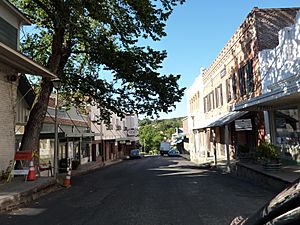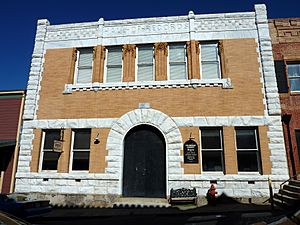San Andreas, California facts for kids
Quick facts for kids
San Andreas, California
|
|
|---|---|

Main Street
|
|
| Motto(s):
“It’s not our fault.”
|
|
| Country | |
| State | |
| County | |
| Area | |
| • Total | 8.394 sq mi (21.741 km2) |
| • Land | 8.378 sq mi (21.700 km2) |
| • Water | 0.016 sq mi (0.041 km2) 0.19% |
| Elevation | 926 ft (268 m) |
| Population
(2020)
|
|
| • Total | 2,994 |
| • Density | 356.68/sq mi (137.712/km2) |
| Time zone | UTC-8 (Pacific (PST)) |
| • Summer (DST) | UTC-7 (PDT) |
| ZIP codes |
95249-95250
|
| Area code(s) | 209 |
| FIPS code | 06-64420 |
| GNIS feature IDs | 277590, 2409247 |
| Reference #: | 252 |
San Andreas is a small town in Calaveras County, California. Its name comes from Californio Spanish and means "St. Andrew." It is the main town, or county seat, of Calaveras County.
In 2010, about 2,783 people lived there. The town was founded during the exciting time of the California Gold Rush. San Andreas is located on State Route 49 and is recognized as California Historical Landmark #252.
Contents
History of San Andreas
Mexican gold miners first settled San Andreas in 1848. They named it after the Catholic parish St. Andrew. From its early days, it was a well-known mining camp.
For the first few years, San Andreas was mostly a "tent city." This meant many buildings, even a church, were made of tents. A short distance outside of town is the Pioneer Cemetery, which started around 1851.
Gold Discoveries and Growth
In August 1982, a large piece of gold was found in San Andreas. It was sold to Wells Fargo & Co. for $12,000. The first gold found from placer mining (gold found in riverbeds) ran out after a few years.
However, in 1853, gold was discovered in an underground river channel. This new discovery brought the town back to life. San Andreas quickly grew into a proper town. Mining the gold channels was so profitable that the town rebuilt completely after big fires in 1858 and 1863. The gold found here helped the Union a lot during the Civil War.
In 1866, San Andreas became the main town of Calaveras County. It was also known as a meeting place for a famous person named Joaquin Murrieta. The town's post office opened in 1854.
Geography and Climate
San Andreas covers about 8.4 square miles (21.7 square kilometers). Most of this area is land, with a very small part being water.
Weather in San Andreas
San Andreas has a Mediterranean climate, which is common in the Sierra Nevada foothills. This means winters are cool and wet. Days are mild, nights are chilly, and there is a lot of rain.
Summers are hot and dry. Days are very hot, but nights are cool, and there is very little rain. Because of the "orographic effect," San Andreas gets much more rain than the valley areas to its west. This effect happens when mountains force moist air upwards, causing rain.
| Climate data for United States | |||||||||||||
|---|---|---|---|---|---|---|---|---|---|---|---|---|---|
| Month | Jan | Feb | Mar | Apr | May | Jun | Jul | Aug | Sep | Oct | Nov | Dec | Year |
| Mean daily maximum °F (°C) | 55.5 (13.1) |
60.3 (15.7) |
64.7 (18.2) |
69.6 (20.9) |
79.1 (26.2) |
88.0 (31.1) |
94.9 (34.9) |
94.0 (34.4) |
88.7 (31.5) |
78.6 (25.9) |
64.8 (18.2) |
55.7 (13.2) |
74.5 (23.6) |
| Daily mean °F (°C) | 46.0 (7.8) |
49.7 (9.8) |
53.0 (11.7) |
56.5 (13.6) |
64.0 (17.8) |
71.1 (21.7) |
76.9 (24.9) |
77.0 (25.0) |
72.4 (22.4) |
63.8 (17.7) |
53.3 (11.8) |
46.2 (7.9) |
60.8 (16.0) |
| Mean daily minimum °F (°C) | 36.6 (2.6) |
39.0 (3.9) |
41.3 (5.2) |
43.4 (6.3) |
48.9 (9.4) |
54.2 (12.3) |
59.0 (15.0) |
59.9 (15.5) |
56.1 (13.4) |
48.9 (9.4) |
41.7 (5.4) |
36.7 (2.6) |
47.2 (8.4) |
| Average precipitation inches (mm) | 5.34 (136) |
5.15 (131) |
4.41 (112) |
2.13 (54) |
1.15 (29) |
0.27 (6.9) |
0.04 (1.0) |
0.07 (1.8) |
0.35 (8.9) |
1.50 (38) |
2.82 (72) |
4.21 (107) |
27.45 (697) |
| Average relative humidity (%) | 74.6 | 70.0 | 66.6 | 59.4 | 51.4 | 43.5 | 38.6 | 38.2 | 39.4 | 46.9 | 63.4 | 72.6 | 55.4 |
| Source: PRISM Climate Group | |||||||||||||
Population and People
In 2010, the population of San Andreas was 2,783 people. Most people lived in homes, while a small number lived in group housing or institutions.
There were 1,146 households in the town. About 27% of these households had children under 18. Many households were made up of married couples. About 34% of households had only one person living there. The average household had about 2.26 people.
The population included people of all ages. About 21% were under 18 years old. About 23% were 65 or older. The average age in San Andreas was 45.7 years.
Most homes were occupied, with about 55% owned by the people living in them. The rest were rented.
See also
 In Spanish: San Andreas (California) para niños
In Spanish: San Andreas (California) para niños



